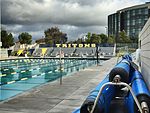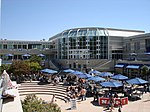California Institute for Telecommunications and Information Technology
The California Institute for Telecommunications and Information Technology (Calit2, previously Cal(IT)2), also referred to as the Qualcomm Institute (QI) at its San Diego branch, is a $400 million academic research institution jointly run by the University of California San Diego (UCSD) and the University of California, Irvine (UCI); in January 2022, plans were announced to add University of California, Riverside to the consortium. Calit2 was established in 2000 as one of the four UC Gray Davis Institutes for Science and Innovation. As a multidisciplinary research institution, it is conducting research discovering new ways in which emerging technologies can improve the state's economy and citizens' quality of life. Keeping in mind its goal of addressing large-scale societal issues, Calit2 extends beyond education and research by also focusing on the development and deployment of prototype infrastructure for testing new solutions in real world environments. Calit2 also provides an academic research environment in which students can work alongside industry professionals to take part in conducting research and prototyping and testing new technologies. Since 2008, Calit2 has implemented its strategic plan, Path Forward. The plan is based on the four core enabling technologies of wireless telecommunications, photonics, nanotechnology and micro-electro-mechanicals systems (MEMS), and cyber space in order to digitally transform applications in culture, health, energy, and the environment. Partnering with companies such as Broadcom, Cisco Systems, Hitachi, and Google Earth, Calit2 has collaborated with more than 250 industry names on sponsored research, technology licensing, and spinoffs based on Calit2 inventions. The State of California provided a $100 million grant to Calit2 to support the design and construction of both campus buildings and facilities. Calit2 also receives support from other funding agencies such as the National Science Foundation, National Institutes of Health, CalTrans, and the UC Discovery Program.
Excerpt from the Wikipedia article California Institute for Telecommunications and Information Technology (License: CC BY-SA 3.0, Authors).California Institute for Telecommunications and Information Technology
Voigt Drive, San Diego Torrey Pines
Geographical coordinates (GPS) Address Website External links Nearby Places Show on map
Geographical coordinates (GPS)
| Latitude | Longitude |
|---|---|
| N 32.882679 ° | E -117.234545 ° |
Address
Atkinson Hall (Calit2) (CalIT2 Building)
Voigt Drive
92092 San Diego, Torrey Pines
California, United States
Open on Google Maps






